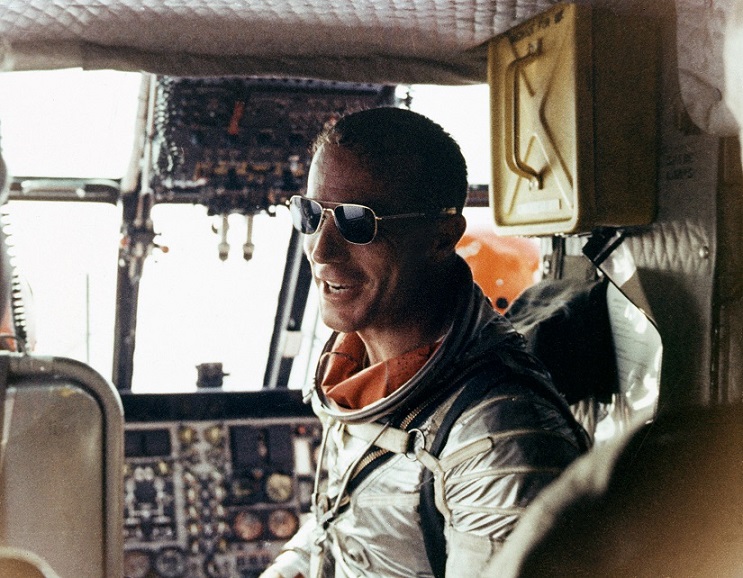
Fifty years ago, this week, Scott Carpenter became America’s second man in orbit. He was one of the most accomplished members of the “Mercury Seven.” In fact, at a December 1960 peer vote, his contemporary John Glenn had placed Carpenter at the top of his personal list for who he thought should be the first into space. When he finally flew into orbit, Carpenter was tasked with the most comprehensive program of scientific research yet seen on a manned mission: astronomical observations, Earth observations, studies of visibility and flying abilities, and medical checks. Sadly, as described in yesterday’s AmericaSpace history article, Carpenter’s voyage aboard Aurora 7 also suffered from severe technical problems, including a faulty pitch horizon scanner and a worrisome decline in fuel quantities in both his manual and automatic tanks. The consequence would be a mission that remains controversial to this very day.
In his autobiography, For Spacious Skies, co-authored with his daughter, Kris Stoever, Carpenter noted that Flight Director Chris Kraft became increasingly frustrated with his performance after concluding that the astronaut had deliberately ignored a request to perform an attitude check. Kraft also voiced serious concerns that Carpenter should tightly curb his automatic fuel use prior to retrofire. “He was fascinated by the view and spent too much time, and used too much fuel, pointing the capsule to look around,” Kraft wrote in his autobiography, Flight. “He got the camera working and lost himself in taking pictures.” The flight director was acutely aware that fuel would be needed for the precise alignment and control of Aurora 7 during retrofire, but Carpenter had failed to take steps to conserve it, after having twice been asked to do so by Capcoms Gordon Cooper and Gus Grissom. Kraft went so far as to describe the astronaut as “joyriding through space and using fuel at an alarming rate” and felt that Carpenter “either didn’t understand or was ignoring my instructions” by failing to reply in a timely fashion to requests for attitude control system reports.
By this time, Aurora 7 was restricted to long periods of drifting flight, with both automatic and manual fuel quantities having fallen to less than 50 percent. Years later, Assistant Flight Director Gene Kranz blamed ground controllers for waiting too long in addressing Aurora 7’s problematic fuel status and felt that they should have been more forceful in getting on with the checklists. “A thorough attitude check, during the first orbit,” added Carpenter, “would probably have helped to diagnose the persistent, intermittent and constantly varying malfunction of the pitch horizon scanner. By the third orbit, it was all too late.”
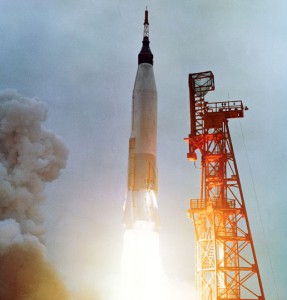
During his period of drifting, Carpenter would recall one of the most spectacular views of the entire mission: a sunrise, witnessed four hours and 19 minutes after launch, shortly before retrofire. “Stretching away for hundreds of miles to the north and the south,” he wrote, sunrise presented “a glittering, iridescent arc” of colors, which faded into a purplish-blue and blended into the blackness of space. This blackness, he wrote in his post-flight report, together with brilliant shades of blue and green from the sunlit Earth, were “colors hard to imagine or duplicate because of their wonderful purity. Everywhere the Earth is flecked with white clouds.” The South Atlantic, he recounted, had a cloud coverage of 90 percent, but western Africa was completely clear and Carpenter had a stunning view of Lake Chad. He saw patchy clouds over the Indian Ocean, a fairly clear Pacific, and an obscured western half of Baja California.
His long period of drifting flight also meant that he also had the opportunity to witness a phenomenon known as “fireflies,” seen previously by John Glenn. By rapping his knuckles on the inside of the spacecraft, he found that he could raise a cloud of them and determined that they came from Aurora 7 itself. “I can rap the hatch and stir off hundreds of them,” he reported. “Rap the side of the capsule: huge streams come out.” To him, they appeared like snowflakes and did not appear to be “luminous,” varying in size, brightness, and color. Some were grey, some white, and one in particular, he said, looked like a helical shaving from a lathe. Carpenter decided, with only minutes remaining before retrofire, to yaw the spacecraft in order to get a better view with the photometer. Shortly thereafter, he passed over Hawaii and was told to reorient Aurora 7, go to autopilot, and begin stowing equipment and running through pre-retrofire checklists.
More problems arose, however. Four hours and 26 minutes after launch, with retrofire barely six minutes away, Carpenter reported that the automatic system did not appear to be working properly. In his autobiography, he later recounted that the autopilot was not holding the spacecraft steady, and, indeed, achieving the correct pitch and yaw attitudes were critical to ensuring that he would descend along a pre-determined re-entry flight path and plop into the waters of the Atlantic, just southeast of Florida. Carpenter promptly switched to the fly-by-wire controls, but forgot to shut off the manual system, which wasted even more fuel. At around the same time, a pair of fuses overheated and the astronaut noticed smoke drifting through the cabin.
“He was behind in stowing equipment,” explained Chris Kraft in Flight. “He hadn’t gotten a good start on his retrofire procedures and, as I listened to him, he sounded confused.” Concerned that the critically timed retrofire would now be delayed by the autopilot malfunction, Carpenter initiated it manually. He fired the rockets three seconds late; a tiny error of timing, but enough at his immense velocity to produce a splashdown point several kilometres “long” in the prime recovery area. “If any of the rockets didn’t burn exactly right, Scott Carpenter was about to be in deep, deep trouble,” wrote Kraft. “The Lord was with him and the rockets were perfect.” Although he radioed that his attitude was good, privately, Carpenter was not sure and added that “the gyros are not quite right.” Years later, he described the difficulty in dividing his attention between two attitude reference systems and attempting to accomplish a perfect retrofire. “It appears I pretty much nailed the pitch,” he wrote, “but the nose of Aurora 7, while pitched close to the desirable negative 34 degrees, was canted about 25 degrees off to the right, in yaw, at the moment of retrofire. By the end of the retrofire event, I had essentially corrected the error in yaw, which limited the overshoot. But the damage was already done.”
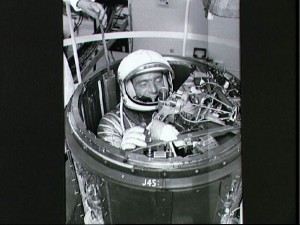
The 25-degree cant alone would cause Aurora 7 to miss its planned splashdown point by around 175 miles (280 km); however, the three-second delay in firing the retrorockets and a thrust decrement of three percent below normal contributed an additional 75 miles (120 km) to the overshoot. On the other hand, if Carpenter had not bypassed the autopilot and manually fired the retrorockets, he could have splashed down even further afield.
At this stage, the spacecraft’s fuel supplies read barely 20 percent for manual and 5 percent for automatic. Carpenter survived re-entry, but experienced a wild ride through the atmosphere, as Aurora 7 oscillated between plus and minus 30 degrees in pitch and yaw. The astronaut was able to damp out many oscillations with the fly-by-wire controls and, indeed, the post-flight report would commend him as having “demonstrated an ability to orient the vehicle so as to effect a successful re-entry,” providing clear evidence that a human pilot could overcome malfunctioning automatic systems.
Carpenter’s descent and Aurora 7’s large trapezoid window offered him a spectacular view of Earth. “I can make out very small farmland, pastureland below,” he reported, four hours and 37 minutes after launch. “I see individual fields, rivers, lakes, roads, I think.” Five minutes later, he was informed that weather conditions in the anticipated recovery zone were good. By this time, Carpenter began to see the first hints of an intense orange glow as particles from the ablative heat shield formed an enormous “wake” behind him. Then came distinct green flashes, which the astronaut assumed were the ionizing beryllium shingles on Aurora 7’s hull. As re-entry G forces peaked at 11 times their normal terrestrial load, cardiac readings at Mission Control revealed the substantial physical effort needed by Carpenter to speak words, announce observations, and make status reports. At one point, he had to be reminded to close his helmet visor.
Five minutes before splashdown, at an altitude of 4.7 miles (7.6 km), he manually deployed the drogue parachute, which steadied the capsule and damped out what he had earlier described as “some pretty good oscillations.” The drogue was soon followed by the main chute, again manually deployed, although Carpenter’s announcements fell on deaf ears. No one could hear his transmissions, and Capcom Virgil “Gus” Grissom was forced to broadcast “in the blind” to inform him that his splashdown point would be some 250 miles (400 km) “long” and advise that pararescue forces would arrive on the scene within the hour. A minute before splashdown, Carpenter acknowledged Grissom’s call. The impact with the water, 135 miles (215 km) northeast of Puerto Rico, he wrote later, was not hard, but Aurora 7 was totally submerged for a few seconds. It popped back up and listed sharply, 60 degrees over to one side, before the landing bag filled and began to act as a sea anchor.
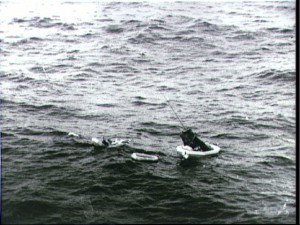
Keen to get out as soon as possible, Carpenter exited the capsule through the nose, becoming the only Mercury astronaut to do so. It took him four minutes and required him to remove the instrument panel from the bulkhead, exposing a narrow egress up through the spacecraft’s nose, where the two parachutes had resided. As he squirmed his way through the cramped space, he decided not to deploy his pressure suit’s neck dam. He was already overheating and felt that the gently swelling seas would make it unnecessary. Next, still perched in the nose of the capsule, he dropped his life raft into the water, where it quickly inflated and a search and rescue homing beacon came on automatically. The latter would guide recovery forces to his position.
As he prepared himself for a long wait, Carpenter tied the life raft to the side of the capsule, finally deployed his neck dam, said a brief prayer, and relaxed. He stretched out on his raft and was joined, he wrote later, by “a curious, 18-inch-long black fish who wanted nothing more than to visit.” It was his first physical contact with another living being and his first moment of calm in four hours and 56 minutes since launch.
For those watching the mission from afar, however, there was no relaxation. At Cape Canaveral, CBS veteran Walter Cronkite played up the drama by describing Mission Control’s repeated attempts to contact Aurora 7. “While thousands watch and pray,” Cronkite told his audience, “certainly here at Cape Canaveral, the silence is almost intolerable.” In Manhattan’s Grand Central Terminal, a hush fell over the crowd gathered before a huge CBS screen, while in the White House a direct telephone link with Cape Canaveral had been set up to provide President John F. Kennedy with news. In fact, the homing beacon had already provided Carpenter’s co-ordinates and his heartbeat had been clearly heard in Mission Control throughout re-entry.
Aboard the destroyer USS John R. Pierce (the “Fierce Pierce”), the attitude was quite different, thanks to the reception of a strong signal from the beacon. “Believe you me,” reported CBS journalist Bill Evenson from aboard the destroyer, “this bucket of bolts is really rolling now and what a happy crew we’ve got!”
It was a Lockheed P2V Neptune, one of the same breed of patrol aircraft that Carpenter himself flew, a decade earlier, in Korea, that finally greeted him. The astronaut signalled the pilot with a hand mirror and was acknowledged when the Neptune began circling his position. One hour and seven minutes after splashdown, at 1:48 p.m. EDT, Airman First Class John Heitsch and Sergeant Ray McClure from an SC-54 transport aircraft joined the astronaut in the water, opened their rafts, and tethered them together. Carpenter offered them some of his food rations, which were politely declined. Eventually, the astronaut was picked up by the USS Intrepid, originally earmarked as the prime recovery ship, but delayed in its arrival by Aurora 7’s 250-mile (400-km) overshoot. The Fierce Pierce, meanwhile, successfully recovered the spacecraft itself and delivered it, on 28 May, to Roosevelt Roads in Puerto Rico.
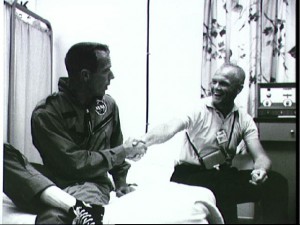
Carpenter was hot and wet after almost an hour on his back on the launch pad, followed by five hours in space and more than an hour in the Atlantic. Soon after boarding the rescue helicopter, he borrowed a pocket knife, cut a hole in the sock of his space suit and let his sweat and seawater drain out of the makeshift toe hole.
Army physician Richard Rink asked him how he felt. In true Mercury Seven fashion, came the clipped response: “Fine.”
The situation within Mission Control, though, was far from fine. Deke Slayton had been stationed at the capcom’s console at the Muchea tracking site in Australia, which he described as “a good place to be, all things considered.” Flight Director Chris Kraft, and many other mission controllers, were furious, accusing Carpenter of having recklessly endangered himself during a botched re-entry. Their anger was exacerbated when, aboard the recovery ship, the astronaut had off-handedly remarked that “I didn’t know where I was … and they didn’t know where I was, either.” One controller is said to have retorted: “Bullshit! That son-of-a-bitch is damned lucky to be alive!”
Kraft, apparently, was considerably more caustic. His team knew exactly Carpenter’s position and had even advised the astronaut when to expect air rescue teams to arrive. “He was sitting in his life raft, enjoying the calm weather,” wrote Kraft, “when frogmen jumped from a plane behind him and startled him by swimming up.” The flight director’s concerns about Carpenter extended long before the mission. He had already voiced reservations about Carpenter’s competence, believing him to be the least experienced of the Original Seven Mercury astronauts and with a poor knowledge of the role of Capcom in Mission Control. “In my opinion,” Kraft wrote in Flight, “Carpenter’s engineering skills were substandard and … he might well jeopardize himself and the program during the mission.”
Kraft described Carpenter’s “cavalier dismissal of a life-threatening problem”—the failure of the spacecraft’s navigational instruments—and troublesome re-entry and swore that the astronaut would never fly again. Scott Carpenter had indeed seen the end of his spacefaring days and after a month-long tour in the U.S. Navy’s Sealab-II underwater habitat, off the coast of La Jolla, Calif., resigned from NASA in 1967. Some have seen Carpenter’s mistakes and omissions as evidence that the early Mercury flights were overloaded with experiments and maneuvers and that Mission Control was partly to blame for failing to identify the horizon pitch scanner malfunction. Tom Wolfe wrote in The Right Stuff that any speculation that Carpenter had panicked was unlikely, “in light of the telemetered data concerning his heart rate and his respiratory rate.”
Aurora 7, though harrowing, was certainly viewed as a success by Carpenter’s family and hundreds of thousands of residents of Colorado, his home state. In Denver, a 300,000-strong crowd cheered the nation’s newest astronaut son in their own ticker-tape parade. The city of Boulder declared 29 May 1962 as Scott Carpenter Day, sponsoring its biggest celebration, and the University of Colorado named the astronaut its most distinguished graduate. Years earlier, Carpenter’s own father, a research chemist, had achieved the same accolade from the same institution. In the case of the younger Carpenter, however, it also came with the formal conferring of his engineering degree, which he completed in 1949, save for a final examination in thermodynamics. The university granted the degree on the grounds that his “subsequent training as an astronaut has more than made up for the deficiency in the subject of heat transfer.”
Carpenter’s flight brought Project Mercury to a crossroads. Speaking before the Exchange Club in Hampton, Va., NASA engineer Joe Dodson pointed out that the lessons learned from Glenn and Carpenter were pleasing, and speculation arose that a day-long mission, to rival that of Gherman Titov in Vostok 2, could be attempted as early as 1963. Indeed, many congressional observers supported a flight to surpass that of Titov. Within a year of Scott Carpenter’s mission—a mission of so many mixed blessings—Project Mercury would draw to a triumphant conclusion and would open the way for Project Gemini and, later, an assault on reaching the Moon itself.
This is part of a series of history articles, which will appear each weekend, barring any major news stories. Next week’s article will focus on the 50th anniversary of Gemini IV, which featured the United States’ first Extravehicular Activity (EVA).
Want to keep up-to-date with all things space? Be sure to “Like” AmericaSpace on Facebook and follow us on Twitter: @AmericaSpace




A very interesting and thorough perspective on Carpenter’s flight.
Whenever I see a Mercury spacecraft, I can’t help but think that the Mercury astronauts have to be some of the bravest people ever. The Atlas didn’t exactly have a great history. And that itty-bitty spacecraft being all that was between you and the void. I’m a wimp.
The “Right Stuff” to be sure!
“The Atlas didn’t exactly have a great history. And that itty-bitty spacecraft being all that was between you and the void. I’m a wimp.”
Von Braun was not impressed with the Atlas at all- not at all. If I recall it took a demonstration with someone taking a sledgehammer to a pressurized Atlas test article sitting in a hangar for him to admit the concept had some merit. As it turned out the Saturn V upper stages (and many present day upper stages) were different from Atlas only in degree- they also required pressurizing like a balloon to maintain enough structural strength to keep from collapsing under flight loads.
The “itt-bitty spacecraft” could have docked with a train of Agena stages and flew around the Moon and that would have been it for the space race. No Gemini, no Apollo,…just some clever engineer with some pull saying, “hey, we just need to fly around the Moon to win, we don’t need to actually land.” Docking the Mercury to an Agena, and docking that combination to another Agena, or some variation, might have pulled off a lunar flyby very early in the space race and everybody might have lost interest. Possible. A Gemini lunar flyby was also proposed later.
If you want to send a single astronaut somewhere then just clamping a little Mercury-size capsule to a larger vehicle is all that is required- the astronaut can space walk to an airlock so no docking is even required. Actually, no airlock is needed either, just a hatch on an empty upper stage, then pressuring it to live in for a week or so- and a booster and away he or she goes. But such “cheap” joyrides prove nothing and accomplish nothing.
Carpenter going to Sealab is an interesting parallel to the space program in one way- submersibles and living under the sea was also being pushed by many people as a new frontier during the 60’s and 70’s but the expense was just too high and the payoff did not merit any development further than a very small market for oil rig work. Deep sea saturation divers suffered from an ailment called pressure induced bone necrosis and astronauts suffer the counterpart to this with radiation exposure and a higher probability of cancer.
Armored diving suits and remote vehicles have largely replaced saturation divers. The system of bearings used on these armored diving suit joints has also been proposed for space suits. And of course the high probability of subsurface oceans on several gas giant moons again connects with manned submersibles and armored divings suits- but probably not saturation diving since even with far less gravity the pressures in the gas giant moon oceans equate to the deep ocean on Earth.
“-astronauts suffer the counterpart to this with radiation exposure and a higher probability of cancer.”
I forgot to mention microgravity debilitation also. The solution to health hazards for saturation divers were armored diving suits and the solution for astronauts are also simple enough- artificial gravity (tether-generated artificial gravity was tested on Gemini 11 in 1966)and massive shielding. That mass of radiation shielding being available in the form of water-derived-from-lunar-ice.
I’d like to find out more? I’d care to find out more details.